SN/T 1055-2002
基本信息
标准号: SN/T 1055-2002
中文名称:出口坚果中氧化苯丁锡残留量检验方法 原子吸收分光光度法
标准类别:商检行业标准(SN)
标准状态:现行
出版语种:简体中文
下载格式:.zip .pdf
下载大小:18414870
相关标签: 出口 坚果 氧化 残留量 检验 方法 原子 吸收 光度法
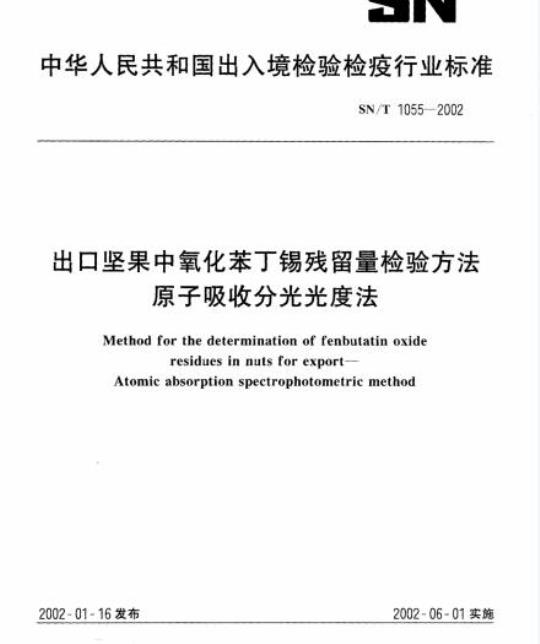
标准分类号
关联标准
出版信息
相关单位信息
标准简介
SN/T 1055-2002.Method for the determination of fenbutatin oxide residues in nuts for export Atomic absorption spectrophotometric method.
1范围
SN/T 1055规定了出口坚果中氧化苯丁锡残留量检验的抽样、制样和原子吸收分光光度测定方法。
SN/T 1055适用于出口栗子、核桃等坚果中氧化苯丁锡残留量的检验。
2抽样和制样
2.1 抽样批次
以同种类、同等级为一抽样批次,每个抽样批次不得大于50t。
2.2抽样数量
50件及以下抽取5件。
51~100件按件数的10%抽取。
101~500件以100件抽取10件为基础,其余件数按6%抽取。
501~1000件以500件抽取34件为基础,其余件数按3%抽取。
计算样件数量时,不足一件者按- -件计。每件抽样数量应基本-致,核桃不得少于20颗,每批样品不得少于500颗;栗子每件抽样数量不得少于500 g,每批样品不得少于4 kg.
2.3试样制备
将所取原始样品缩分出1kg,取可食部分,经样品均质器碎化,均分成2份,装人洁净容器内,作为试样,密封,并标明标记。
2.4试样 保存
将试样于-18℃冷冻保存。
注:在抽样和制样的操作过程中,必须防止样品受到污染或发生残留物含量的变化。
3测定方法
3.1 方法提要
以二氯甲烷-冰乙酸混合溶剂,提取试样中氧化苯丁锡残留,提取液经离心分离,浓缩至干后,残渣用湿法消化,溶解定容后,用配有氢化物发生系统、外焰加热石英管原子化器的原子吸收分光光度计测定,外标法定量。
1范围
SN/T 1055规定了出口坚果中氧化苯丁锡残留量检验的抽样、制样和原子吸收分光光度测定方法。
SN/T 1055适用于出口栗子、核桃等坚果中氧化苯丁锡残留量的检验。
2抽样和制样
2.1 抽样批次
以同种类、同等级为一抽样批次,每个抽样批次不得大于50t。
2.2抽样数量
50件及以下抽取5件。
51~100件按件数的10%抽取。
101~500件以100件抽取10件为基础,其余件数按6%抽取。
501~1000件以500件抽取34件为基础,其余件数按3%抽取。
计算样件数量时,不足一件者按- -件计。每件抽样数量应基本-致,核桃不得少于20颗,每批样品不得少于500颗;栗子每件抽样数量不得少于500 g,每批样品不得少于4 kg.
2.3试样制备
将所取原始样品缩分出1kg,取可食部分,经样品均质器碎化,均分成2份,装人洁净容器内,作为试样,密封,并标明标记。
2.4试样 保存
将试样于-18℃冷冻保存。
注:在抽样和制样的操作过程中,必须防止样品受到污染或发生残留物含量的变化。
3测定方法
3.1 方法提要
以二氯甲烷-冰乙酸混合溶剂,提取试样中氧化苯丁锡残留,提取液经离心分离,浓缩至干后,残渣用湿法消化,溶解定容后,用配有氢化物发生系统、外焰加热石英管原子化器的原子吸收分光光度计测定,外标法定量。
标准图片预览
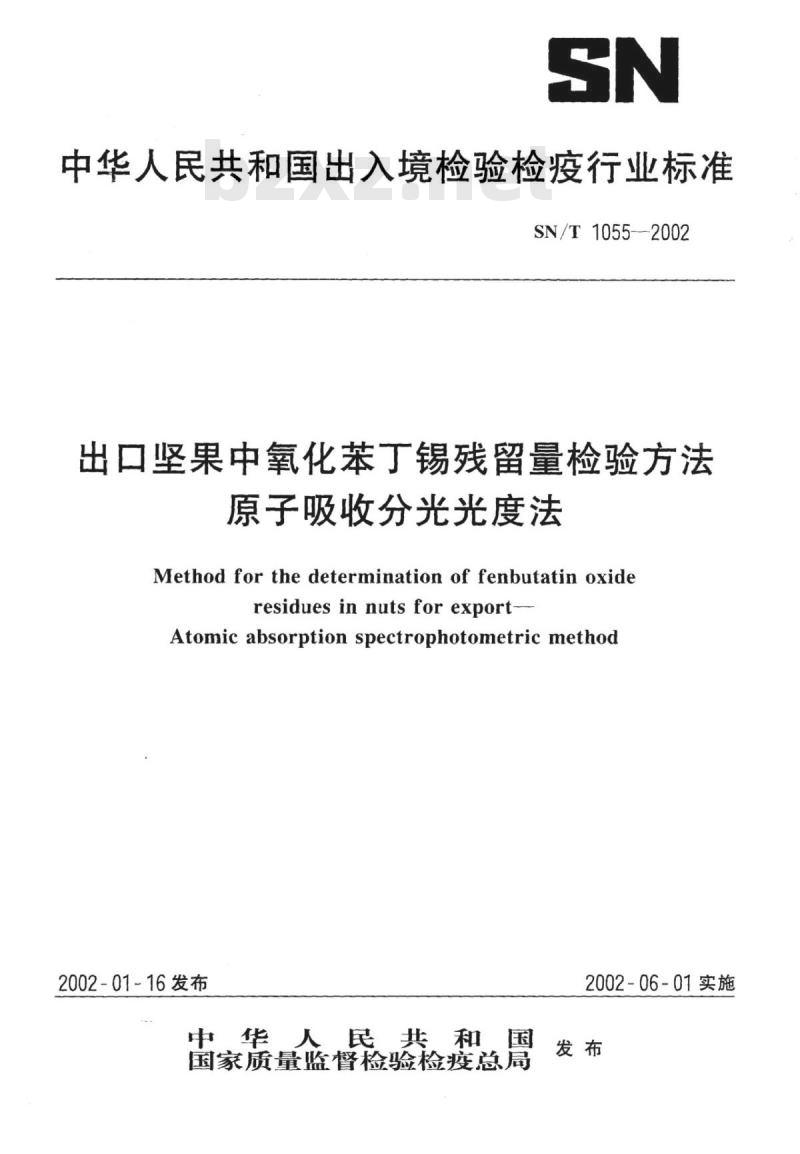
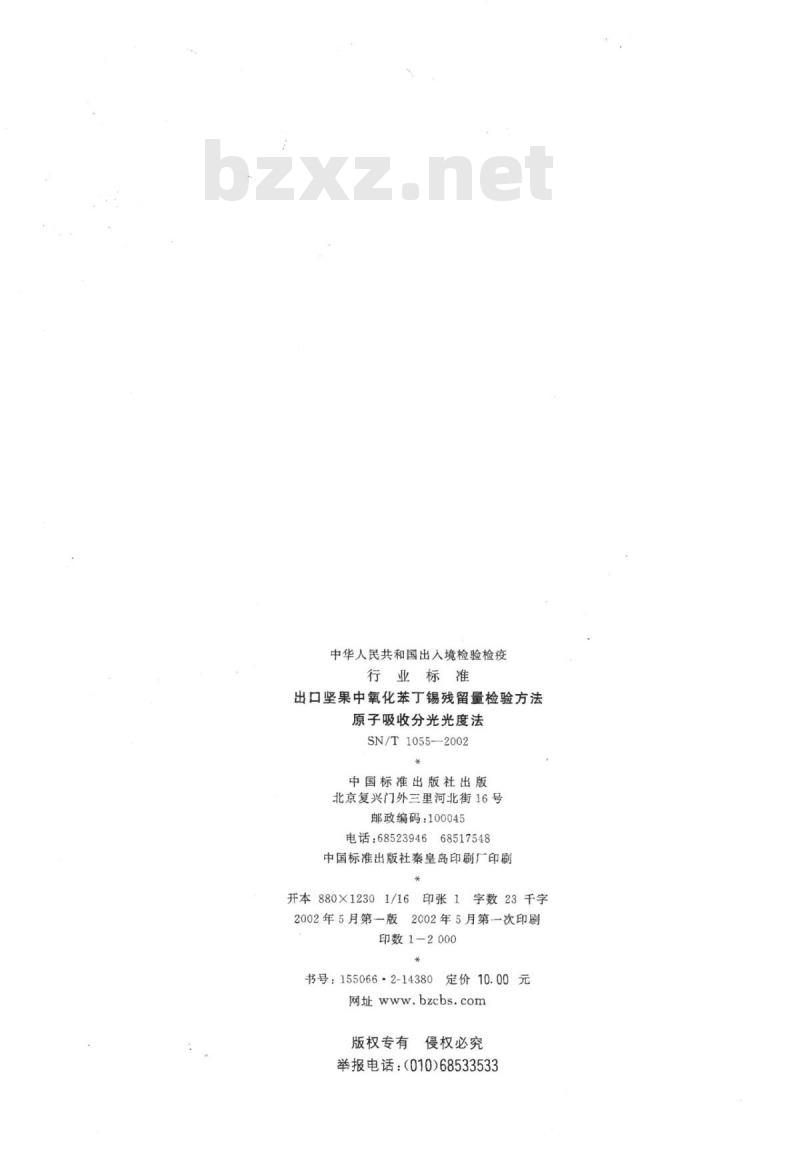
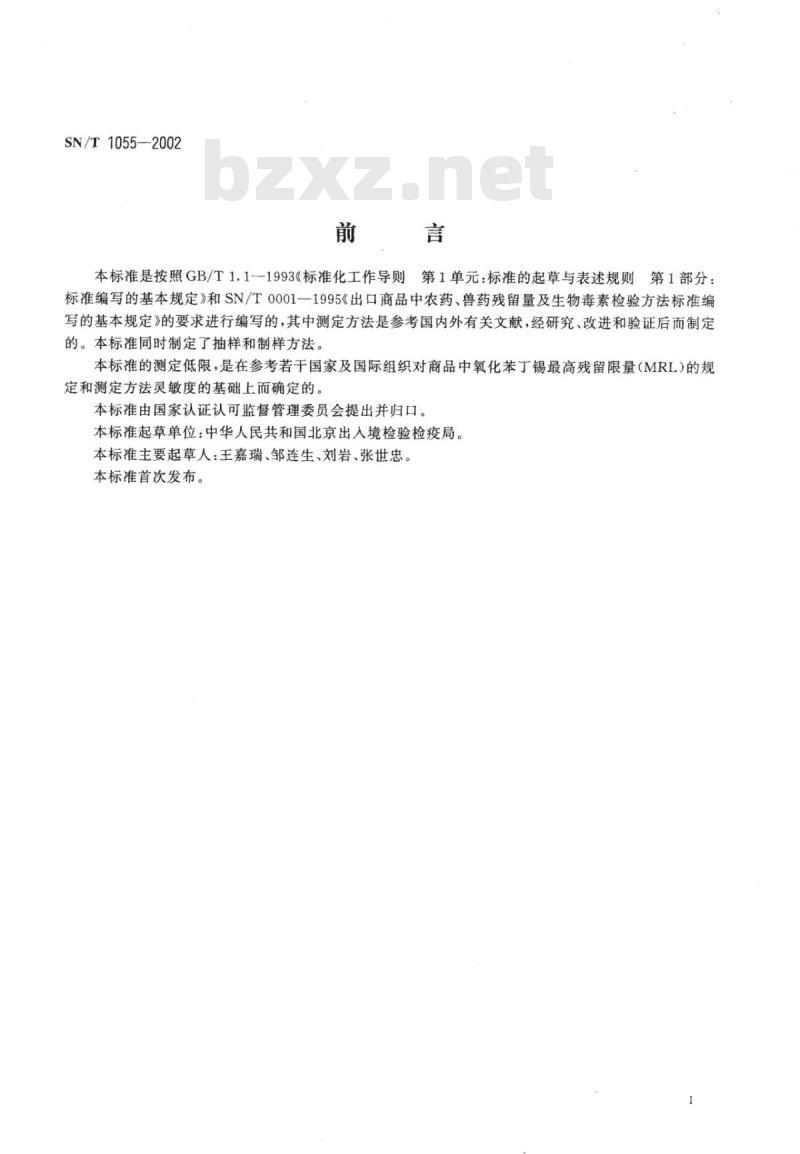

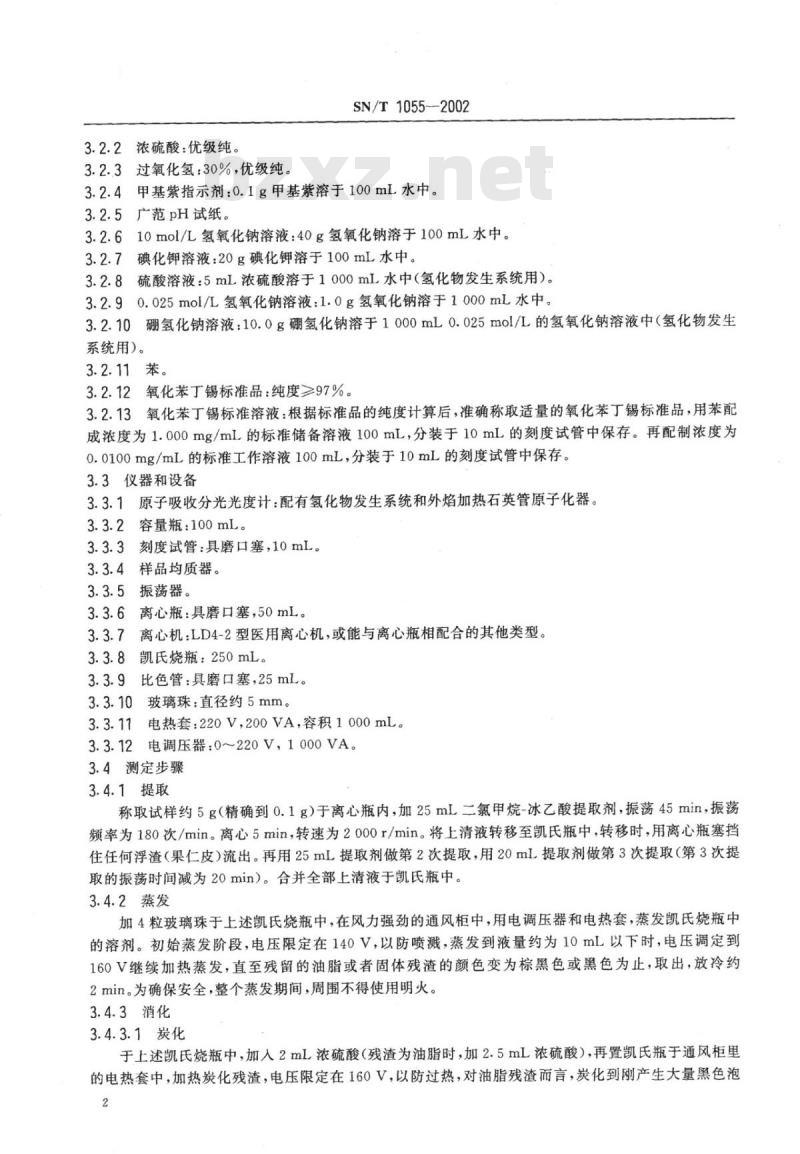
标准内容
中华人民共和国出入境检验检疫行业标准SN/T1055-2002
出口坚果中氧化苯丁锡残留量检验方法原子吸收分光光度法
Method for the determination of fenbutatin oxideresidues innutsforexport
Atomic absorption spectrophotometric method2002-01-16发布
中华人民共和国
国家质量监督检验检疫总局
2002-06-01实施
中华人民共和国出入境检验检疫行业标准
出口坚果中氧化苯丁锡残留量检验方法原子吸收分光光度法
SN/T1055—2002
中国标准出版社出版
北京复兴门外三里河北街16号
邮政编码:100045
电话:6852394668517548
中国标准出版社秦皇岛印刷厂印刷开本880X12301/16印张1字数23千字2002年5月第一版2002年5月第一次印刷印数1-2000
书号:155066·2-14380定价10.00元网址bzcbs.com
版权专有
侵权必究
举报电话:(010)68533533
SN/T1055—2002
本标准是按照GB/T1.11993《标准化工作导则第1单元:标准的起草与表述规则第1部分:标准编写的基本规定》和SN/T0001-—1995《出口商品中农药、兽药残留量及生物毒素检验方法标准编写的基本规定》的要求进行编写的,其中测定方法是参考国内外有关文献,经研究、改进和验证后而制定的。本标准同时制定了抽样和制样方法。本标准的测定低限,是在参考若干国家及国际组织对商品中氧化苯丁锡最高残留限量(MRL)的规定和测定方法灵敏度的基础上而确定的。本标准由国家认证认可监督管理委员会提出并归口。本标准起草单位:中华人民共和国北京出入境检验检疫局。本标准主要起草人:王嘉瑞、邹连生、刘岩、张世忠。本标准首次发布。
1范围
中华人民共和国出入境检验检疫行业标准出口坚果中氧化苯丁锡残留量检验方法原子吸收分光光度法
Method for the determination of fenbutatin oxideresidues in nuts for export
Atomic absorption spectrophotometric methodSN/T1055--2002
本标准规定了出口坚果中氧化苯丁锡残留量检验的抽样、制样和原子吸收分光光度测定方法。本标准适用于出口栗子、核桃等坚果中氧化苯丁锡残留量的检验。2抽样和制样
2.1抽样批次
以同种类、同等级为一抽样批次,每个抽样批次不得大于50t。2.2抽样数量
50件及以下抽取5件。
51~100件按件数的10%抽取。
101~500件以100件抽取10件为基础,其余件数按6%抽取。501~1000件以500件抽取34件为基础,其余件数按3%抽取。计算样件数量时,不足一件者按一件计。每件抽样数量应基本一致,核桃不得少于20颗,每批样品不得少于500颗;栗子每件抽样数量不得少于500g,每批样品不得少于4kg。2.3试样制备
将所取原始样品缩分出1kg,取可食部分,经样品均质器碎化,均分成2份,装入洁净容器内,作为试样,密封,并标明标记。
2.4试样保存
将试样于一18℃冷冻保存。
注:在抽样和制样的操作过程中,必须防止样品受到污染或发生残留物含量的变化。3测定方法
3.1方法提要
以二氯甲烷-冰乙酸混合溶剂,提取试样中氧化苯丁锡残留,提取液经离心分离,浓缩至干后,残渣用湿法消化,溶解定容后,用配有氢化物发生系统、外焰加热石英管原子化器的原子吸收分光光度计测定,外标法定量。
3.2试剂和材料
除另有注明外,试剂均为分析纯,水为去离子水。3.2.1提取剂:二氯甲烷-冰乙酸,6十4(V/V)。中华人民共和国国家质量监督检验检疫总局2002-01-16批准2002-06-01实施
3.2.2浓硫酸:优级纯。
3.2.3过氧化氢:30%,优级纯。SN/T1055--2002
3.2.4甲基紫指示剂:0.1g甲基紫溶于100mL水中。3.2.5广范pH试纸。
10mol/L氢氧化钠溶液:40g氢氧化钠溶于100mL水中。3.2.6
碘化钾溶液:20g碘化钾溶于100mL水中。硫酸溶液:5mL浓硫酸溶于1000mL水中(氢化物发生系统用)。0.025mol/L氢氧化钠溶液:1.0g氢氧化钠溶于1000mL水中。3.2.9
3.2.10硼氢化钠溶液:10.0g硼氢化钠溶于1000mL0.025mol/L的氢氧化钠溶液中(氢化物发生系统用)。
3.2.11苯。
3.2.12氧化苯丁锡标准品:纯度≥97%。3.2.13氧化苯丁锡标准溶液:根据标准品的纯度计算后,准确称取适量的氧化苯丁锡标准品,用苯配成浓度为1.000mg/mL的标准储备溶液100mL,分装于10mL的刻度试管中保存。再配制浓度为0.0100mg/mL的标准工作溶液100mL,分装于10mL的刻度试管中保存。3.3仪器和设备
3.3.1原子吸收分光光度计:配有氢化物发生系统和外焰加热石英管原子化器。3.3.2容量瓶:100mL。
3.3.3刻度试管:具磨口塞,10mL。3.3.4样品均质器。
3.3.5振荡器。
离心瓶:具磨口塞,50mL。
离心机:LD4-2型医用离心机,或能与离心瓶相配合的其他类型。3.3.8告
凯氏烧瓶:250mL。
3.3.9比色管:具磨口塞,25mL。3.3.10
玻璃珠:直径约5mm。wwW.bzxz.Net
3.3.11电热套:220V,200VA,容积1000mL。电调压器:0~220V,1000VA。
3.4测定步骤
3.4.1提取
称取试样约5g(精确到0.1g)于离心瓶内,加25mL二氯甲烷-冰乙酸提取剂,振荡45min,振荡频率为180次/min。离心5min,转速为2000r/min。将上清液转移至凯氏瓶中,转移时,用离心瓶塞挡住任何浮渣(果仁皮)流出。再用25mL提取剂做第2次提取,用20mL提取剂做第3次提取(第3次提取的振荡时间减为20min)。合并全部上清液于凯氏瓶中。3.4.2蒸发
加4粒玻璃珠于上述凯氏烧瓶中,在风力强劲的通风柜中,用电调压器和电热套,蒸发凯氏烧瓶中的溶剂。初始蒸发阶段,电压限定在140V,以防喷溅,蒸发到液量约为10mL以下时,电压调定到160V继续加热蒸发,直至残留的油脂或者固体残渣的颜色变为棕黑色或黑色为止,取出,放冷约2min。为确保安全,整个蒸发期间,周围不得使用明火。3.4.3消化
3.4.3.1炭化
于上述凯氏烧瓶中,加入2mL浓硫酸(残渣为油脂时,加2.5mL浓硫酸),再置凯氏瓶于通风柜里的电热套中,加热炭化残渣,电压限定在160V,以防过热,对油脂残渣而言,炭化到刚产生大量黑色泡2
沫为止,取出,放冷2min。
3.4.3.2消化
SN/T1055—2002
加入10mL过氧化氢于上述凯氏瓶中,置凯氏瓶于通风柜里的电热套中,加热消化残渣,电压限定在160V,以防反应过于激烈,至过氧化氢作用完全时,立即取出(不得延误,延误将导致硫酸熬干),放冷2min。重复加过氧化氢,直至消化液变为无色透明时为止,取出,放冷2min。注:对油脂残渣而言,在过氧化氢第一次作用完全时,出现激烈的炭化反应,同时产生大量的黑色泡沫,此时应立即取出凯氏瓶,放冷2min,然后再从加过氧化氢开始,重复消化操作。过氧化氢作用完全时,反应的激烈程度,一次比一次缓和,产生的黑色泡沫的量,一次比一次少。未消化掉的残液的颜色,也一次比一次浅,由最初的黑色,变为深棕色、浅棕色、黄色、浅黄色直至最后消化完全时,残液变为无色。3.4.3.3消化凯氏瓶颈上的残留物加人20mL过氧化氢于上述凯氏瓶中,凯氏瓶放回通风柜里的电热套中,电压调定到200V,消化至溶液冒白烟,呈透明无色,无任何微小气泡时为止,以确保过氧化氢被完全分解,并确保硫酸不被挥发至干。取出凯氏瓶,放冷后,供配制原子吸收测试溶液用。3.4.4标准工作溶液的消化
按5g试样量计算,从浓度为0.0100mg/mL的氧化苯丁锡标准工作溶液中,准确吸取0.00,0.10,0.20,0.30,0.40mL(相当于试样中氧化苯丁锡含量为0.00,0.20,0.40,0.60,0.80mg/kg),分别放人一组编号的凯氏烧瓶中,各加入4粒玻璃珠,在风力强劲的通风柜中,用电热套和电调压器,电压调定在140V,加热挥发凯氏烧瓶中的溶剂至干,取出放冷,加人0.5mL浓硫酸,20mL过氧化氢,电压调定在200V,加热消化,消化至溶液冒白烟,呈透明无色,无微小气泡时为止,以确保过氧化氢被完全分解,并确保硫酸不被挥发至干。取出凯氏瓶,放冷后,供配制原子吸收测试溶液用。3.4.5原子吸收测试溶液的配制
3.4.5.1消化残液的溶解和定量转移分3次,每次5mL水,分别溶解、洗涤凯氏烧瓶中的标准和试样的消化残液,定量转移至比色管中,供降低酸度和定容使用。
3.4.5.2降低测试溶液的酸度并定容降低酸度操作,应逐一在比色管中进行,以防止指示剂过早加入而失效。往比色管中加入6滴甲基紫指示剂,摇匀,用10mol/L的氢氧化钠溶液,分次加人,降低溶液的酸度,并不断用流水冷却比色管,溶液由黄色,变为黄绿色、绿色直至蓝色为止。降低酸度的操作,必须一次完成,中间不得中断,否则指示剂在低酸度条件下很快退色失效,使降低酸度的操作失败。为确保酸度不会降低过头显碱性,用广范pH试纸检验一下调酸后的溶液,试纸显示酸色即可。再加人5mL碘化钾溶液,用水稀释至25mL刻度线,摇匀,静置5min后,进行原子吸收测定。3.4.6测定
3.4.6.1原子吸收测定条件
配有氢化物发生系统、外焰加热石英管原子化器的原子吸收分光光度计的测定条件如下:a)波长:224.6nm;
b)狭缝宽度:1.30nm;
c)灯电流:12.5mA;
d)火焰:空气-乙炔焰;
e)燃气流量:2.0L/min;
f)空气压强:160kPa;
g)空气流量:15.0L/min;
h)时间恒定值:2.00s;
i)测量时间:15.0s;
j)延迟时间:5s;
k)测量次数:2;
SN/T1055—2002
1)浓度单位:mg/kg(样品中氧化苯丁锡的含量单位);m)进样体积:5mL。
3.4.6.2原子吸收测定
按照设定好的仪器测试条件,测定每份标准的测试溶液和试样的测试溶液的原子吸收吸光度。3.4.7空白试验
除不加试样外,均按上述测定步骤进行。3.4.8结果计算与表述
用原子吸收分光光度计的数据处理机,或按式(1)计算试样中氧化苯丁锡的残留量:AA
式中:X——试样中氧化苯丁锡残留量,mg/kg;A———试样的原子吸收吸光度测定值;A。空白试验原子吸收吸光度测定值;k——标准曲线线性回归方程斜率,(mg/kg)-14方法的测定低限、回收率
4.1测定低限
本方法的测定低限为0.10mg/kg。4.2回收率
.(1)
回收率的试验数据:试样中氧化苯丁锡的添加浓度在0.10~0.80mg/kg范围时,回收率为87.5%~110.0%。
SN/T10552002
Foreword
This standard was drafted in accordance with the requirement of GB/T1.1-1993\Directives forthe work of standardization--Unit 1:Drafting and presentation of standards-Part 1:General rulesfor drafting standards\and SN/T oo01-1995\General rules for drafting the standard methods forthe determination of pesticide,veterinary drug residues and biotoxins in commodities for export.\The method of determination of this standard was drafted by referring to relational domestic andforeign literature through research,modification and verification.In addition,methods of samplingand sample preparation are also specified in this standard.The limit of determination in this standard is defined on the basis of the current international maxi-mum limits for fenbutatin oxide residues in foodstuffs and the sensitivity of the method.This standard was proposed by and is under the charge of National Regulatory Commission forCertilicationandAccreditation.This standard was drafted by Beijing Bureau for Entry-Exit Inspection and Quarantine of the People's Republic of China.
The main drafters of this standard are Wang Jiarui,Zou Liansheng,Liu Yan,Zhang ShizhongThis standard is aprofessional standard promulgated forthe first time.Note:ThisEnglishversion,atranslationfromtheChinesetextissolelyforguidanceProfessionalStandardof thePeople'sRepublic of ChinaforEntry-ExitInspectionandQuarantineMethodfordeterminationof fenbutatinoxideresidues innuts for export-Atomic absorption spectrophotometric method7
SN/T1055-—2002
This standard specifies the method of sampling,sample preparation and determination of fenbu-tatin oxide residues in nuts for export by the atomic absorption spectrophotometry.This standard is applicable to the determination of fenbutatin oxide residues in nuts such as sweet-nut,walnutforexport.
2Samplingandsamplepreparation2.1Inspectionlot
An inspection lot should be same type and same grade,each lot should not be more than 5o tons.2.2Quantityof sampletaken
Numberofpiecein
eachinspection lot
51~100
101~500
501~1000
Minimum number of
piece to be opened
10piece of100 piece
+6% remainderpiece.
34pieceof500piece
+3%remainderpiece.
When calculate the number of piece,less than one piece should be assumed as one piece.Thequantitytaken from one piece should be same,for walnut,should not be less than 2o grains apiece;for sweetnut,should not be less than 500 grams a piece.For one inspection lot,the quantityof sample taken should not be less than 4kg.2.3 Preparation of test sampleThe combined primary sample is reduced to 1kg,the edible portion is blended,and then dividedinto two equal portions.Each portion is placed in a clean container as the test sample,which isApproved by General Administration of QualitySupervision,Inspection and Quarantine of thePeople'sRepublic of China on2002-01-166
implementedfrom2002-06-01
sealed and labeled.
2.4Storageof testsample
SN/T1055-—2002
Thetestsamplesshouldbestoredat-18℃Note:In thecourseof samplingand test samplepreparationprmay cause the change of residues content3Methodofdetermination
3.1Principle
istbetaken to avoid the contamination orany factorswhichAfter the sample is extracted by the dichloromethane-glacial acetic acid mixed solvent,the solutionis centrifuged,separated,and concentrated to dryness,the dryness residue is digested by sulfuricacid and oxide reagents,then the digested solution is diluted to a definite volume.Finally,the solu-tion is analyzed by the atomic absorption spectrophotometer equipped with a hydride formationsystem and an external flame heating quartz tube for the atomic vapor formation,using externalstandard method for the quantitative determination3.2Reagents andmaterials
Unless otherwise specified,the purity of all of reagents is A.R.,the water is distilled water.3.2.1Extraction reagent:dichloromethane-glacial aceticacid,6+4(V/V)3.2.2 Concentration sulfuric acid:High class purity.3.2.3Hydrogenperoxide:30%,high classpurity.3.2.4 Methyl violet indicator solution:0.1 gram methyl violet is dissolved in 100 mL water.3.2.5 Universal indicatorpaper:pH1~14.3.2.610 mol/L solution of sodium hydroxide:40 gram sodium hydroxide is dissolved in 100 mLwater.
3.2.7Potassiumiodidesolution:20gramspotassiumiodideisdissolved in100mLwater3.2.8 Solution of sulfuric acid:5 mL concentrated sulfuric acid dissolved in 1 ooo mL water (tobe used forhydride formation system).3.2.90.025 mol/L solution of sodium hydroxide:1.0 gram sodium hydroxide is dissolved in1000mLwater.
3.2.10Sodium borohydried:10.0 gramsodiumborohydride is dissolved in1000mL0.025mol/Lsolutionof sodiumhydroxide(to beusedforhydrideformationsystem).7
3.2.11Benzene.
SN/T1055—2002
3.2.12 Fenbutatin oxide standard material:Purity:≥97%3.2.13 Fenbutatin oxide standard solution:After the calculation according to the purity of fenbu-tatin oxide,accurately weigh adequate amount of fenbutatin oxide standard material,dissolved inbenzen and prepare 100 mL solution of the concentration as 1.000 mg/mL,divided into the 10 mLgraduated test tubes as the standard stock solution.Then prepare again 1oo mL solution of theconcentration as 0.010 0 mg/mL,divided into the 10 mL graduated test tubes as the standardworkingsolution.
3.3Apparatus and equipment
3.3.1 The atomic absorption spectrophotometer:Equipped with a hydride formation system andan external flameheating quartz tubeforatomicvaporformation.3.3.2Measuringflask:100mL
3.3.3Graduatedtesttube:10mL,withgroundstopper3.3.4Samplehomogenizer.
3.3.5 Shaker.
3.3.6Centrifugebottle:5omL,withgroundstopper.3.3.7Centrifuger:LD-4model,or othermodelthat canmatch withthe centrifugebottle3Kjeldahl'sflask:250mL.
Colorimetric testtube:25mL,with ground stopper3.3.10
Glasspearlabout5mmdiameter.
Electrical heating mantle:220 V,200 VA,size 1000 mL.3.3.11
2Voltageadjuster:0~220V,1000VA.3.3.12
Procedure
Extraction
Weigh ca 5 g of the test sample (accurate to 0.1g)into a centrifuge bottle, add 25mLdichloromethane-glacial acetic acid mixed extract reagent and stopper,the bottle is shaken for 458
SN/T1055—2002
min.by a shaker, shaking frequency is about 180 times/min.Then the centrifuge bottle is centrifuged for 5 min by a centrifuger,rotating speed is about 2 0oo r/min,then the clean solution isdecanted into the Kjeldahl's flask,during the decanting,the floating dregs (such as peel of kernel)is kept off by ground stopper of centrifuge bottle to prevent decanting out.Then the test sample isextracted second time by 25 mL,third time by 20 mL extract reagent (during third extracting,theshaken time is reduced as 20 min).All of the clean solutions are combined into the Kjeldahl'sflask.
Evaporation
Add 4 pellets of glass pearls into the above Kjeldahl's flask,in the draught chamber with a strongwind power,heat the Kjeldahl's flask by the electrical heating mantle and the voltage adjuster toevaporate the extract solvent,During the initial evaporating,the voltage is kept at 14o V to preventerupting.When the volume of solvent is less than 10 mL,the voltage is increased to 160 Vto con-tinue heating for evaporation,when the color of residue (oil or solid residue) is getting dark brownor dark,stop heating,take out the flask to cool about 2 min.For safety reason,guarantee no flameexistonthesurroundingduringthewholeevaporating.3.4.3Digestion
3.4.3.1Carbonization
Add2mL concentrated sulfuric acid(for oil residue,add 2.5mL)into aboveKjeldahl's flask,thenput it back into the electrical heating mantle in the draught chamber,heat the flask to carbonize theresidue,the voltage is adjusted as 16o V to prevent over heat.For oil residue,the carbonizingshould not stop until a great number of dark foam just is occur,then the flask is taken out to coolabout2min.
3.4.3.2Digestion
Add 1o mL hydrogen peroxide into the above Kjeldahl's flask,then put it back into the electricalheating mantle in the draught chamber,heat and digest the content in flask,the voltage is adjustedas 16o V to prevent the reaction from too drastically.When the hydrogen peroxide is reacted out,take out the flask right away (should not delay,if delay,the sulfuric acid will be dried out)to coolabout 2 min.Repeat adding the hydrogen peroxide operation and don't stop until the digestedresidue liquid has become clear and transparent,take out the flask to cool about 2 min.Note: For oil residue,when the hydrogen peroxide is reacted out for the first time,the violent carbonizing reaction isoccurred,at the same time a great number of dark foam is occurred,at this time the flask should be taken outto cool about 2 min,then repeat the digestion operation with adding the peroxide hydrogen,Whenever the hy-drogen peroxide is reacted out,the reaction is more gentle than last time is,the amount of dark foam is lessthan last time is,the color ofresidue liquid is lighter than last time isit is progressively getting from initialblack,to dark brown,light brown,yellow,light yellow,and finallythe color of residue liquid is colorless andtransparent.
小提示:此标准内容仅展示完整标准里的部分截取内容,若需要完整标准请到上方自行免费下载完整标准文档。
出口坚果中氧化苯丁锡残留量检验方法原子吸收分光光度法
Method for the determination of fenbutatin oxideresidues innutsforexport
Atomic absorption spectrophotometric method2002-01-16发布
中华人民共和国
国家质量监督检验检疫总局
2002-06-01实施
中华人民共和国出入境检验检疫行业标准
出口坚果中氧化苯丁锡残留量检验方法原子吸收分光光度法
SN/T1055—2002
中国标准出版社出版
北京复兴门外三里河北街16号
邮政编码:100045
电话:6852394668517548
中国标准出版社秦皇岛印刷厂印刷开本880X12301/16印张1字数23千字2002年5月第一版2002年5月第一次印刷印数1-2000
书号:155066·2-14380定价10.00元网址bzcbs.com
版权专有
侵权必究
举报电话:(010)68533533
SN/T1055—2002
本标准是按照GB/T1.11993《标准化工作导则第1单元:标准的起草与表述规则第1部分:标准编写的基本规定》和SN/T0001-—1995《出口商品中农药、兽药残留量及生物毒素检验方法标准编写的基本规定》的要求进行编写的,其中测定方法是参考国内外有关文献,经研究、改进和验证后而制定的。本标准同时制定了抽样和制样方法。本标准的测定低限,是在参考若干国家及国际组织对商品中氧化苯丁锡最高残留限量(MRL)的规定和测定方法灵敏度的基础上而确定的。本标准由国家认证认可监督管理委员会提出并归口。本标准起草单位:中华人民共和国北京出入境检验检疫局。本标准主要起草人:王嘉瑞、邹连生、刘岩、张世忠。本标准首次发布。
1范围
中华人民共和国出入境检验检疫行业标准出口坚果中氧化苯丁锡残留量检验方法原子吸收分光光度法
Method for the determination of fenbutatin oxideresidues in nuts for export
Atomic absorption spectrophotometric methodSN/T1055--2002
本标准规定了出口坚果中氧化苯丁锡残留量检验的抽样、制样和原子吸收分光光度测定方法。本标准适用于出口栗子、核桃等坚果中氧化苯丁锡残留量的检验。2抽样和制样
2.1抽样批次
以同种类、同等级为一抽样批次,每个抽样批次不得大于50t。2.2抽样数量
50件及以下抽取5件。
51~100件按件数的10%抽取。
101~500件以100件抽取10件为基础,其余件数按6%抽取。501~1000件以500件抽取34件为基础,其余件数按3%抽取。计算样件数量时,不足一件者按一件计。每件抽样数量应基本一致,核桃不得少于20颗,每批样品不得少于500颗;栗子每件抽样数量不得少于500g,每批样品不得少于4kg。2.3试样制备
将所取原始样品缩分出1kg,取可食部分,经样品均质器碎化,均分成2份,装入洁净容器内,作为试样,密封,并标明标记。
2.4试样保存
将试样于一18℃冷冻保存。
注:在抽样和制样的操作过程中,必须防止样品受到污染或发生残留物含量的变化。3测定方法
3.1方法提要
以二氯甲烷-冰乙酸混合溶剂,提取试样中氧化苯丁锡残留,提取液经离心分离,浓缩至干后,残渣用湿法消化,溶解定容后,用配有氢化物发生系统、外焰加热石英管原子化器的原子吸收分光光度计测定,外标法定量。
3.2试剂和材料
除另有注明外,试剂均为分析纯,水为去离子水。3.2.1提取剂:二氯甲烷-冰乙酸,6十4(V/V)。中华人民共和国国家质量监督检验检疫总局2002-01-16批准2002-06-01实施
3.2.2浓硫酸:优级纯。
3.2.3过氧化氢:30%,优级纯。SN/T1055--2002
3.2.4甲基紫指示剂:0.1g甲基紫溶于100mL水中。3.2.5广范pH试纸。
10mol/L氢氧化钠溶液:40g氢氧化钠溶于100mL水中。3.2.6
碘化钾溶液:20g碘化钾溶于100mL水中。硫酸溶液:5mL浓硫酸溶于1000mL水中(氢化物发生系统用)。0.025mol/L氢氧化钠溶液:1.0g氢氧化钠溶于1000mL水中。3.2.9
3.2.10硼氢化钠溶液:10.0g硼氢化钠溶于1000mL0.025mol/L的氢氧化钠溶液中(氢化物发生系统用)。
3.2.11苯。
3.2.12氧化苯丁锡标准品:纯度≥97%。3.2.13氧化苯丁锡标准溶液:根据标准品的纯度计算后,准确称取适量的氧化苯丁锡标准品,用苯配成浓度为1.000mg/mL的标准储备溶液100mL,分装于10mL的刻度试管中保存。再配制浓度为0.0100mg/mL的标准工作溶液100mL,分装于10mL的刻度试管中保存。3.3仪器和设备
3.3.1原子吸收分光光度计:配有氢化物发生系统和外焰加热石英管原子化器。3.3.2容量瓶:100mL。
3.3.3刻度试管:具磨口塞,10mL。3.3.4样品均质器。
3.3.5振荡器。
离心瓶:具磨口塞,50mL。
离心机:LD4-2型医用离心机,或能与离心瓶相配合的其他类型。3.3.8告
凯氏烧瓶:250mL。
3.3.9比色管:具磨口塞,25mL。3.3.10
玻璃珠:直径约5mm。wwW.bzxz.Net
3.3.11电热套:220V,200VA,容积1000mL。电调压器:0~220V,1000VA。
3.4测定步骤
3.4.1提取
称取试样约5g(精确到0.1g)于离心瓶内,加25mL二氯甲烷-冰乙酸提取剂,振荡45min,振荡频率为180次/min。离心5min,转速为2000r/min。将上清液转移至凯氏瓶中,转移时,用离心瓶塞挡住任何浮渣(果仁皮)流出。再用25mL提取剂做第2次提取,用20mL提取剂做第3次提取(第3次提取的振荡时间减为20min)。合并全部上清液于凯氏瓶中。3.4.2蒸发
加4粒玻璃珠于上述凯氏烧瓶中,在风力强劲的通风柜中,用电调压器和电热套,蒸发凯氏烧瓶中的溶剂。初始蒸发阶段,电压限定在140V,以防喷溅,蒸发到液量约为10mL以下时,电压调定到160V继续加热蒸发,直至残留的油脂或者固体残渣的颜色变为棕黑色或黑色为止,取出,放冷约2min。为确保安全,整个蒸发期间,周围不得使用明火。3.4.3消化
3.4.3.1炭化
于上述凯氏烧瓶中,加入2mL浓硫酸(残渣为油脂时,加2.5mL浓硫酸),再置凯氏瓶于通风柜里的电热套中,加热炭化残渣,电压限定在160V,以防过热,对油脂残渣而言,炭化到刚产生大量黑色泡2
沫为止,取出,放冷2min。
3.4.3.2消化
SN/T1055—2002
加入10mL过氧化氢于上述凯氏瓶中,置凯氏瓶于通风柜里的电热套中,加热消化残渣,电压限定在160V,以防反应过于激烈,至过氧化氢作用完全时,立即取出(不得延误,延误将导致硫酸熬干),放冷2min。重复加过氧化氢,直至消化液变为无色透明时为止,取出,放冷2min。注:对油脂残渣而言,在过氧化氢第一次作用完全时,出现激烈的炭化反应,同时产生大量的黑色泡沫,此时应立即取出凯氏瓶,放冷2min,然后再从加过氧化氢开始,重复消化操作。过氧化氢作用完全时,反应的激烈程度,一次比一次缓和,产生的黑色泡沫的量,一次比一次少。未消化掉的残液的颜色,也一次比一次浅,由最初的黑色,变为深棕色、浅棕色、黄色、浅黄色直至最后消化完全时,残液变为无色。3.4.3.3消化凯氏瓶颈上的残留物加人20mL过氧化氢于上述凯氏瓶中,凯氏瓶放回通风柜里的电热套中,电压调定到200V,消化至溶液冒白烟,呈透明无色,无任何微小气泡时为止,以确保过氧化氢被完全分解,并确保硫酸不被挥发至干。取出凯氏瓶,放冷后,供配制原子吸收测试溶液用。3.4.4标准工作溶液的消化
按5g试样量计算,从浓度为0.0100mg/mL的氧化苯丁锡标准工作溶液中,准确吸取0.00,0.10,0.20,0.30,0.40mL(相当于试样中氧化苯丁锡含量为0.00,0.20,0.40,0.60,0.80mg/kg),分别放人一组编号的凯氏烧瓶中,各加入4粒玻璃珠,在风力强劲的通风柜中,用电热套和电调压器,电压调定在140V,加热挥发凯氏烧瓶中的溶剂至干,取出放冷,加人0.5mL浓硫酸,20mL过氧化氢,电压调定在200V,加热消化,消化至溶液冒白烟,呈透明无色,无微小气泡时为止,以确保过氧化氢被完全分解,并确保硫酸不被挥发至干。取出凯氏瓶,放冷后,供配制原子吸收测试溶液用。3.4.5原子吸收测试溶液的配制
3.4.5.1消化残液的溶解和定量转移分3次,每次5mL水,分别溶解、洗涤凯氏烧瓶中的标准和试样的消化残液,定量转移至比色管中,供降低酸度和定容使用。
3.4.5.2降低测试溶液的酸度并定容降低酸度操作,应逐一在比色管中进行,以防止指示剂过早加入而失效。往比色管中加入6滴甲基紫指示剂,摇匀,用10mol/L的氢氧化钠溶液,分次加人,降低溶液的酸度,并不断用流水冷却比色管,溶液由黄色,变为黄绿色、绿色直至蓝色为止。降低酸度的操作,必须一次完成,中间不得中断,否则指示剂在低酸度条件下很快退色失效,使降低酸度的操作失败。为确保酸度不会降低过头显碱性,用广范pH试纸检验一下调酸后的溶液,试纸显示酸色即可。再加人5mL碘化钾溶液,用水稀释至25mL刻度线,摇匀,静置5min后,进行原子吸收测定。3.4.6测定
3.4.6.1原子吸收测定条件
配有氢化物发生系统、外焰加热石英管原子化器的原子吸收分光光度计的测定条件如下:a)波长:224.6nm;
b)狭缝宽度:1.30nm;
c)灯电流:12.5mA;
d)火焰:空气-乙炔焰;
e)燃气流量:2.0L/min;
f)空气压强:160kPa;
g)空气流量:15.0L/min;
h)时间恒定值:2.00s;
i)测量时间:15.0s;
j)延迟时间:5s;
k)测量次数:2;
SN/T1055—2002
1)浓度单位:mg/kg(样品中氧化苯丁锡的含量单位);m)进样体积:5mL。
3.4.6.2原子吸收测定
按照设定好的仪器测试条件,测定每份标准的测试溶液和试样的测试溶液的原子吸收吸光度。3.4.7空白试验
除不加试样外,均按上述测定步骤进行。3.4.8结果计算与表述
用原子吸收分光光度计的数据处理机,或按式(1)计算试样中氧化苯丁锡的残留量:AA
式中:X——试样中氧化苯丁锡残留量,mg/kg;A———试样的原子吸收吸光度测定值;A。空白试验原子吸收吸光度测定值;k——标准曲线线性回归方程斜率,(mg/kg)-14方法的测定低限、回收率
4.1测定低限
本方法的测定低限为0.10mg/kg。4.2回收率
.(1)
回收率的试验数据:试样中氧化苯丁锡的添加浓度在0.10~0.80mg/kg范围时,回收率为87.5%~110.0%。
SN/T10552002
Foreword
This standard was drafted in accordance with the requirement of GB/T1.1-1993\Directives forthe work of standardization--Unit 1:Drafting and presentation of standards-Part 1:General rulesfor drafting standards\and SN/T oo01-1995\General rules for drafting the standard methods forthe determination of pesticide,veterinary drug residues and biotoxins in commodities for export.\The method of determination of this standard was drafted by referring to relational domestic andforeign literature through research,modification and verification.In addition,methods of samplingand sample preparation are also specified in this standard.The limit of determination in this standard is defined on the basis of the current international maxi-mum limits for fenbutatin oxide residues in foodstuffs and the sensitivity of the method.This standard was proposed by and is under the charge of National Regulatory Commission forCertilicationandAccreditation.This standard was drafted by Beijing Bureau for Entry-Exit Inspection and Quarantine of the People's Republic of China.
The main drafters of this standard are Wang Jiarui,Zou Liansheng,Liu Yan,Zhang ShizhongThis standard is aprofessional standard promulgated forthe first time.Note:ThisEnglishversion,atranslationfromtheChinesetextissolelyforguidanceProfessionalStandardof thePeople'sRepublic of ChinaforEntry-ExitInspectionandQuarantineMethodfordeterminationof fenbutatinoxideresidues innuts for export-Atomic absorption spectrophotometric method7
SN/T1055-—2002
This standard specifies the method of sampling,sample preparation and determination of fenbu-tatin oxide residues in nuts for export by the atomic absorption spectrophotometry.This standard is applicable to the determination of fenbutatin oxide residues in nuts such as sweet-nut,walnutforexport.
2Samplingandsamplepreparation2.1Inspectionlot
An inspection lot should be same type and same grade,each lot should not be more than 5o tons.2.2Quantityof sampletaken
Numberofpiecein
eachinspection lot
51~100
101~500
501~1000
Minimum number of
piece to be opened
10piece of100 piece
+6% remainderpiece.
34pieceof500piece
+3%remainderpiece.
When calculate the number of piece,less than one piece should be assumed as one piece.Thequantitytaken from one piece should be same,for walnut,should not be less than 2o grains apiece;for sweetnut,should not be less than 500 grams a piece.For one inspection lot,the quantityof sample taken should not be less than 4kg.2.3 Preparation of test sampleThe combined primary sample is reduced to 1kg,the edible portion is blended,and then dividedinto two equal portions.Each portion is placed in a clean container as the test sample,which isApproved by General Administration of QualitySupervision,Inspection and Quarantine of thePeople'sRepublic of China on2002-01-166
implementedfrom2002-06-01
sealed and labeled.
2.4Storageof testsample
SN/T1055-—2002
Thetestsamplesshouldbestoredat-18℃Note:In thecourseof samplingand test samplepreparationprmay cause the change of residues content3Methodofdetermination
3.1Principle
istbetaken to avoid the contamination orany factorswhichAfter the sample is extracted by the dichloromethane-glacial acetic acid mixed solvent,the solutionis centrifuged,separated,and concentrated to dryness,the dryness residue is digested by sulfuricacid and oxide reagents,then the digested solution is diluted to a definite volume.Finally,the solu-tion is analyzed by the atomic absorption spectrophotometer equipped with a hydride formationsystem and an external flame heating quartz tube for the atomic vapor formation,using externalstandard method for the quantitative determination3.2Reagents andmaterials
Unless otherwise specified,the purity of all of reagents is A.R.,the water is distilled water.3.2.1Extraction reagent:dichloromethane-glacial aceticacid,6+4(V/V)3.2.2 Concentration sulfuric acid:High class purity.3.2.3Hydrogenperoxide:30%,high classpurity.3.2.4 Methyl violet indicator solution:0.1 gram methyl violet is dissolved in 100 mL water.3.2.5 Universal indicatorpaper:pH1~14.3.2.610 mol/L solution of sodium hydroxide:40 gram sodium hydroxide is dissolved in 100 mLwater.
3.2.7Potassiumiodidesolution:20gramspotassiumiodideisdissolved in100mLwater3.2.8 Solution of sulfuric acid:5 mL concentrated sulfuric acid dissolved in 1 ooo mL water (tobe used forhydride formation system).3.2.90.025 mol/L solution of sodium hydroxide:1.0 gram sodium hydroxide is dissolved in1000mLwater.
3.2.10Sodium borohydried:10.0 gramsodiumborohydride is dissolved in1000mL0.025mol/Lsolutionof sodiumhydroxide(to beusedforhydrideformationsystem).7
3.2.11Benzene.
SN/T1055—2002
3.2.12 Fenbutatin oxide standard material:Purity:≥97%3.2.13 Fenbutatin oxide standard solution:After the calculation according to the purity of fenbu-tatin oxide,accurately weigh adequate amount of fenbutatin oxide standard material,dissolved inbenzen and prepare 100 mL solution of the concentration as 1.000 mg/mL,divided into the 10 mLgraduated test tubes as the standard stock solution.Then prepare again 1oo mL solution of theconcentration as 0.010 0 mg/mL,divided into the 10 mL graduated test tubes as the standardworkingsolution.
3.3Apparatus and equipment
3.3.1 The atomic absorption spectrophotometer:Equipped with a hydride formation system andan external flameheating quartz tubeforatomicvaporformation.3.3.2Measuringflask:100mL
3.3.3Graduatedtesttube:10mL,withgroundstopper3.3.4Samplehomogenizer.
3.3.5 Shaker.
3.3.6Centrifugebottle:5omL,withgroundstopper.3.3.7Centrifuger:LD-4model,or othermodelthat canmatch withthe centrifugebottle3Kjeldahl'sflask:250mL.
Colorimetric testtube:25mL,with ground stopper3.3.10
Glasspearlabout5mmdiameter.
Electrical heating mantle:220 V,200 VA,size 1000 mL.3.3.11
2Voltageadjuster:0~220V,1000VA.3.3.12
Procedure
Extraction
Weigh ca 5 g of the test sample (accurate to 0.1g)into a centrifuge bottle, add 25mLdichloromethane-glacial acetic acid mixed extract reagent and stopper,the bottle is shaken for 458
SN/T1055—2002
min.by a shaker, shaking frequency is about 180 times/min.Then the centrifuge bottle is centrifuged for 5 min by a centrifuger,rotating speed is about 2 0oo r/min,then the clean solution isdecanted into the Kjeldahl's flask,during the decanting,the floating dregs (such as peel of kernel)is kept off by ground stopper of centrifuge bottle to prevent decanting out.Then the test sample isextracted second time by 25 mL,third time by 20 mL extract reagent (during third extracting,theshaken time is reduced as 20 min).All of the clean solutions are combined into the Kjeldahl'sflask.
Evaporation
Add 4 pellets of glass pearls into the above Kjeldahl's flask,in the draught chamber with a strongwind power,heat the Kjeldahl's flask by the electrical heating mantle and the voltage adjuster toevaporate the extract solvent,During the initial evaporating,the voltage is kept at 14o V to preventerupting.When the volume of solvent is less than 10 mL,the voltage is increased to 160 Vto con-tinue heating for evaporation,when the color of residue (oil or solid residue) is getting dark brownor dark,stop heating,take out the flask to cool about 2 min.For safety reason,guarantee no flameexistonthesurroundingduringthewholeevaporating.3.4.3Digestion
3.4.3.1Carbonization
Add2mL concentrated sulfuric acid(for oil residue,add 2.5mL)into aboveKjeldahl's flask,thenput it back into the electrical heating mantle in the draught chamber,heat the flask to carbonize theresidue,the voltage is adjusted as 16o V to prevent over heat.For oil residue,the carbonizingshould not stop until a great number of dark foam just is occur,then the flask is taken out to coolabout2min.
3.4.3.2Digestion
Add 1o mL hydrogen peroxide into the above Kjeldahl's flask,then put it back into the electricalheating mantle in the draught chamber,heat and digest the content in flask,the voltage is adjustedas 16o V to prevent the reaction from too drastically.When the hydrogen peroxide is reacted out,take out the flask right away (should not delay,if delay,the sulfuric acid will be dried out)to coolabout 2 min.Repeat adding the hydrogen peroxide operation and don't stop until the digestedresidue liquid has become clear and transparent,take out the flask to cool about 2 min.Note: For oil residue,when the hydrogen peroxide is reacted out for the first time,the violent carbonizing reaction isoccurred,at the same time a great number of dark foam is occurred,at this time the flask should be taken outto cool about 2 min,then repeat the digestion operation with adding the peroxide hydrogen,Whenever the hy-drogen peroxide is reacted out,the reaction is more gentle than last time is,the amount of dark foam is lessthan last time is,the color ofresidue liquid is lighter than last time isit is progressively getting from initialblack,to dark brown,light brown,yellow,light yellow,and finallythe color of residue liquid is colorless andtransparent.
小提示:此标准内容仅展示完整标准里的部分截取内容,若需要完整标准请到上方自行免费下载完整标准文档。